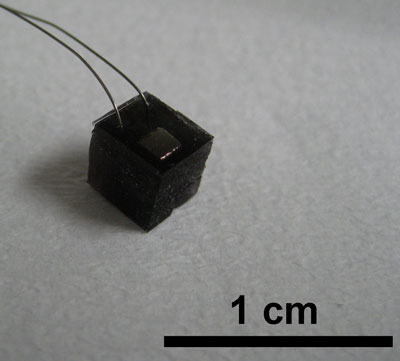| Posted: Dec 20, 2011 | |
Carbon nanotube converter powers implants remotely through laser light |
|
| (Nanowerk Spotlight) Implantable medical devices such as cardiac pacemakers, neurostimulators and drug delivery devices are major medical tools to support life activity and provide new therapeutic strategies. Most such devices are powered by lithium batteries whose service life is as low as 10 years. Hence, many patients must undergo a major surgery to check the battery performance and replace the batteries as necessary. | |
| In previous Nanowerk Spotlights we have looked at various strategies for replacing these batteries with self-powering machines, for instance exploiting the continuous movement of the lungs ("Breathe, and a nanogenerator will power your pacemaker") or the heart ("Nanotechnology converts heartbeat into electricity"). Another approach to power implants internally could rely on biofuel cells that harvest chemical or biochemical energy from inside the body (see "A nanoscale biofuel cell for self-powered nanotechnology devices"). | |
| A team in Japan has now reported another interesting strategy that would keep using batteries but provides a mechanism for remotely recharging them from outside the body by converting laser light into thermal energy and subsequently to electricity. The main purpose of this study was to show that it is possible to remotely control electrical energy generation by laser light that can be transmitted through living tissue in order to target various bionic applications implanted in the body. | |
| "Among various power sources for implanted medical devices, our system is a promising candidate because of its excellent ability to obtain energy directly from external and non-contact laser light and because its production of electricity can be controlled by laser light intensity," Dr. Eijiro Miyako, a research scientist at the Health Research Institute (HRI) at the National Institute of Advanced Industrial Science and Technology (AIST) In Osaka, tells Nanowerk. | |
| Miyako explains that in contrast to electromagnetic coupling – another wireless power supply technique that has been reported and that successfully supplies electric power for an artificial heart through the skin – his team's technique shows no risk of disturbing surrounding instruments through electromagnetic induction. "We think that using laser light rather than electromagnetic coupling is much safer" he says. " | |
| As the researchers report in the December 16, 2011 edition of Angewandte Chemie International Edition ("A Photo-Thermal-Electrical Converter Based On Carbon Nanotubes for Bioelectronic Applications"), at the heart of the system are very finely divided carbon nanotubes (CNTs) embedded in a silicon matrix. The CNTs absorb laser light and convert the light energy very effectively to heat. This heat energy is in turn converted into electric current by the tiny device. | |
 |
|
| Photograph of the CNT-based photo-thermal-electrical converter. (Image: Dr. Miyako, AIST) | |
| "Our device works through the Seebeck effect, the conversion of temperature differences directly into electricity" explains Miyako. "In an electrical circuit made of two different conductors – in this case a special arrangement of semiconductor materials – a temperature difference between the contacts results in a small voltage. Only the side of the device coated with the silicon/carbon nanotube composite that gets irradiated heats up, which provides the required temperature difference." | |
| Because the carbon nanotubes absorb very well in a range of wavelengths that can pass through tissue, the device, which need be no larger than a half-centimeter cube, can be implanted under the skin. Simple irradiation should then allow it to generate enough voltage to charge the battery of a pacemaker or other device. | |
| "To the best of our knowledge, this is the first demonstration of remote control of physiological tissue activities and in vivo electrical power generation through a new type of photo-thermal-electrical converter that exploits the powerful photothermal properties of carbon nanotubes," says Miyako. "Our study also provides a new mechanism for designing various bioelectronic devices, such as a power source for the stimulation of living tissues, a sensing material for optical biotelemetry, and a power supply system for implantable medical devices." | |
| At the moment, the team's converters fall short of delivering the approx. 300 mV of electricity required to charge a battery in implanted medical devices. Safely improving the power generation of their CNT-based material is therefore a key focus of the team's current research efforts. | |
 By
Michael
Berger
– Michael is author of three books by the Royal Society of Chemistry:
Nano-Society: Pushing the Boundaries of Technology,
Nanotechnology: The Future is Tiny, and
Nanoengineering: The Skills and Tools Making Technology Invisible
Copyright ©
Nanowerk LLC
By
Michael
Berger
– Michael is author of three books by the Royal Society of Chemistry:
Nano-Society: Pushing the Boundaries of Technology,
Nanotechnology: The Future is Tiny, and
Nanoengineering: The Skills and Tools Making Technology Invisible
Copyright ©
Nanowerk LLC
|
|
|
Become a Spotlight guest author! Join our large and growing group of guest contributors. Have you just published a scientific paper or have other exciting developments to share with the nanotechnology community? Here is how to publish on nanowerk.com. |
|
